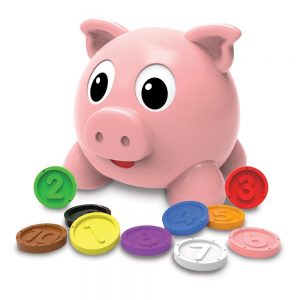
Experian put together a list of five fun ways to teach kids about money, which will help them with financial literacy—and help parents so the kids aren’t living with us forever. Here is part 1 of this 3 part series.
- Toys
You can start very young teaching basics with toys such like these:

Piggy Bank
As early as age 2, there are toys like The Learning Journey Numbers and Colors Pig E Bank, which has colored coins the bank counts as you put them in the slot. You can get this toy for around $19.

Cash Register
Beginning with toddlers (around age 3), you can use a play cash register to let kids play “store” and understand the basics of money. This can help them learn how much money they have, how much they have left when they buy something, and how things add up when you buy multiple things. One popular cash register from Learning Resources costs about $30 on Amazon.

Checkbook
Made for kids 5 and up, this Learning Resources Pretend & Play Checkbook comes with a calculator, checkbook, deposit slips and guide to help kids learn about managing a bank account and writing checks. Even if checks aren’t often used much anymore, it’s still a fun way to help your kids learn about money and debiting accounts. It costs approximately $12.
- Online Games
These games are available online for you to help your kids learn about money and finance:
Cash Puzzler
This simple money game on Visa’s Practical Money Skills site is made for ages 3-6 and involves putting together a “puzzle” from mixed up pieces of a bill ($1-$100).
Smart Money Commanders
Ruby’s Troupe is an organization that uses an interactive theatre with a fun-loving group of puppets to teach kids ages 3-10 (and their parents) about money and finance. The program was created by puppeteer Phyllis Mattson and Debbie Todd, a licensed CPA. It has online modules where children watch puppets, get coloring pages, and have access to games and activities.
“We have three purposes when it comes to teaching about managing money,” Todd explains. “First is for them to find out it’s fun. Second is to find out it’s practical. And third is that they can do it and be successful at it.”
They also focus lessons on the emotional and psychological aspects of money, because that is where a lot of mistakes can be made. They’ve also done live sessions and Todd says it’s amazing to see the “tall kids” (parents) sit in the back and learn with the kids: “By the end, we’ve provided the parents with the tools to have a non-confrontational, non-threatening conversation with their children.”
Ruby’s Troupe also donates 90% of its profits to charity, including nonprofits and foundations that promote financial literacy, which is critically lacking here in the U.S. Only 17 states offer financial literacy courses for high school students and a recent report card by Champlain College’s Center for Financial Literacy gave only five states—Alabama, Missouri, Tennessee, Utah, and Virginia—an ‘A’ grade for providing personal finance education.
Peter Pig’s Money Counter
Made for children from 5-8, this interactive game from Visa helps kids learn about counting and saving money along with U.S. currency.
Clay Piggy
Clay Piggy is an online game created for Kindergarten and above by a parent who didn’t find any fun options when trying to teach her own daughter about money. Students learn basic money management skills such as how to earn, spend, save, invest, and give.
There are different scenarios in the game where they have to take a job to earn money, create a budget, understand wants and needs, watch their credit scores, be a responsible investor by assessing credit profiles of other users who asking for loan, learn how to pay taxes, look at their paychecks and more.
“Parents need to talk to their children about savings and give them situations at an early age where they have to manage money,” explains Narinder Budhiraja, founder of Clay Piggy. “Lots of people learn about money by making mistakes and then spend lot of years fixing their mistakes. This bring lot of stress in their personal life. At Clay Piggy, we are determined to change that behavior.”
Currently Clay Piggy is currently only available for schools to use, but they’re planning to roll out an application for parents later this year.
Money Metropolis
Another game on Visa’s Practical Money Skills site, this one is created for 7-12 year olds to make life decisions that impact whether their virtual bank account will make or earn money.
Mt. Everest Money Simulation
This game is a choose-your-own-adventure simulation where kids help a backpacker plan a trip to Mt. Everest without going into debt. It’s available from Money Prodigy and is made for kids ages 8-13. You can learn more about it and join the wait list here.
Financial Football and Financial Soccer
Visa’s World Cup-themed soccer game is made for ages 11 and up to test financial management skills and the Financial Football game helps kids learn about money management.
Cash Crunch 101
Created for ages 13 and up, Cash Crunch 101 facilitates the conversation about money. It was created by a teacher for the classroom, but can be used by parents and kids as well.
Ellen Sirull is senior manager of content at Experian Consumer Services, a division of Experian, the nation’s largest credit bureau. In her role, she helps consumers learn about credit, personal finance and identity theft protection.
